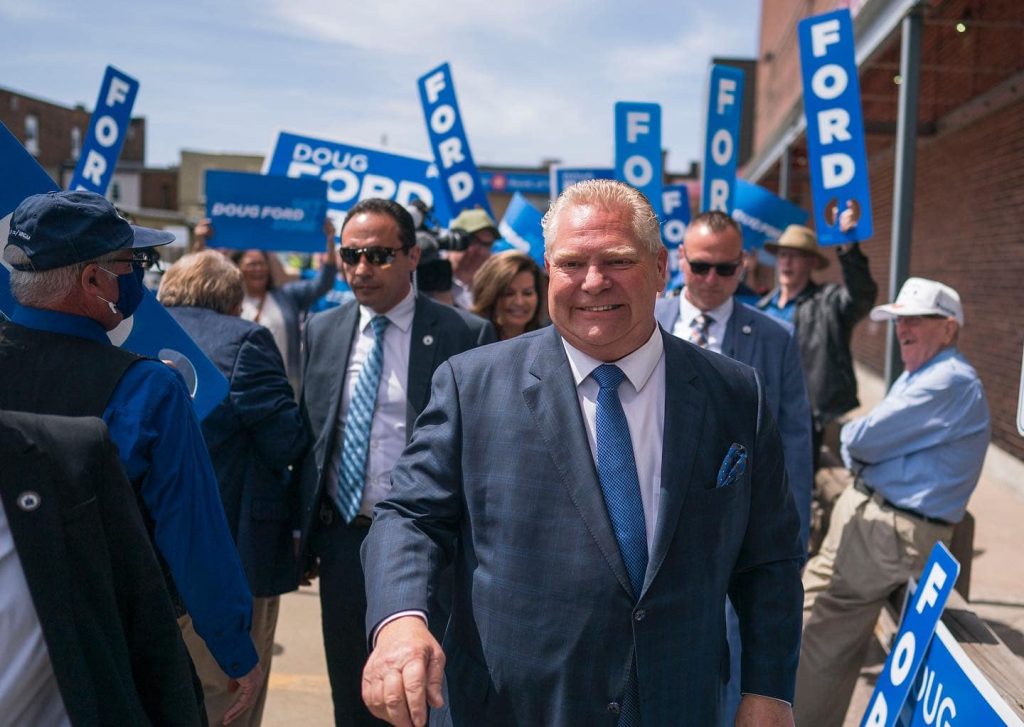Canada News
What Doug Ford’s shift to the centre says about the longevity of populism

The Ontario Progressive Conservative (PC) government’s attempt at re-election brings to the forefront questions of Canadian conservatism and its viability, not just in the country’s most populous province.
Throughout its tenure, the PC government has undergone significant changes in policy, appearance and general tone. A 2018 populist movement has seemingly shifted to the moderate PC coalition of old.
To capture this change, is it necessary for Ford to turn back the clock to 2018? After all, he won both the party leadership and the election on a populist agenda.
Following the more centrist Patrick Brown’s removal as PC leader in January 2018, Ford entered the race brandishing his previous anti-establishment and brash Toronto City Council persona.
In narrowly beating Christine Elliot for the leadership, Ford quickly shifted the image and platform of the party to his own image.
The party’s electoral platform, titled A Plan for the People, contrasted the “people” from the “elites,” who, through waste, mismanagement and scandal, had — along with a set of “special interests” — benefited from exploiting every day Ontarians.
The platform argued that Ford’s PC party, by being better connected to the taxpayer, would bring in a period of fiscal restraint, less wasteful government spending and a more “common-sense” driven policy process. Among the party’s promises were to fire the CEO of Ontario’s utility provider, Hydro One, launch a full audit of Liberal government spending and repeal the province’s cap-and-trade program.
Controversial policies
These initiatives shaped the initial year of the Ford government as it brought in aggressive and controversial policies.
By the time the 2019 spring budget was tabled, the government had scrapped cap-and-trade, legislated an end to the strike at York University, cancelled several green-energy contracts, put in place the student choice initiative that was later struck down, fought teachers’ unions over increased class sizes, limited the salaries of public servants and budgeted significant cutbacks in public spending in addition to $26 billion in tax relief.
In particular, the decision to cut the size of Toronto City Council, coupled with the threat to use the Constitution’s notwithstanding clause to enshrine its bill limiting third-party election advertising, seemed to show the willingness to lash back against conventional norms and institutions.
To many, this was met with a certain dread: critics, particularly those on the left, saw Ford as the “Donald Trump of the North” whose emergence to power marked Canada’s entry into a brash, authoritarian and xenophobic populism seen throughout the world.
Alternatively, many Conservatives positively regarded Ford’s government as a return of former premier Mike Harris’s “Common Sense Revolution” of neo-liberal reform.
Neither of these predictions have turned out to be correct.
The impact of COVID-19
By 2022, Ford and the Progressive Conservatives have come to resemble an older, conservative powerhouse: the “Big Blue Machine” of onetime premiers Leslie Frost, John Robarts and Bill Davis.
This is because rather than making efforts to display its ideological or populist integrity, the Ford government has come to focus more pragmatically on the consequences of each of its policies. In particular, there remains next to no rhetoric on “elites” versus “the people.”
The party was in power for 42 consecutive years in Ontario, from 1943 to 1985, and its success has been attributed to its pragmatic, moderate and borderline bland style of governance, particularly in the way it ensured a consistent level of economic growth.
The change in tone for the Ford government seems to have started in late 2019 when, following a significant drop in popularity, it regrouped via a drastic cabinet shuffle and staffing changes in the premier’s office.
The onset of the COVID-19 pandemic in March 2020 showed a new side to Ford and his government. The government’s response, while far from perfect, suggested Ford was emphatic and, most importantly, concerned about the practical success of policies.
Rather than disparaging the media or other governments as part of the “elite,” the Ford government developed a solid working relationship with the governing federal Liberals.
This new, more moderate and pragmatic tone has taken over the party’s 2022 policy platform, entitled Get It Done — and there appears to be no intention to shift back to right-wing populism.
As Get it Done communicates, the party now bases its appeal in the claim that it can effectively get results and most competently manage the affairs of the province.
This includes providing more benefits for workers, expanding health care and investing $158.8 billion in several large transportation projects. The government’s prior fiscal hawkishness seems to have disappeared given a balanced budget isn’t projected until 2027.
Populism hard to sustain
This suggests that a contrarian populist appeal, while it could be useful in attaining office, is much more difficult to sustain as a coherent, effective and popular governing strategy over time.
As the Ford government learned, an aggressive and contrarian approach can quickly create too many enemies, especially given Ontario’s large and powerful public sector.
This could be unique to Ontario. The province’s political culture has long favoured moderation and pragmatic governance.
But it’s also important to recognize the implications this could have for the rest of Canada, because it provides Canadian Conservative governments with one of two choices in the coming years.
First, form legislatively influential but short-lived populist coalitions or, second, compromise to enjoy a longer, but likely much less impactful, control over the government.![]()
Sam Routley, PhD Student, Political Science, Western University
This article is republished from The Conversation under a Creative Commons license. Read the original article.





















